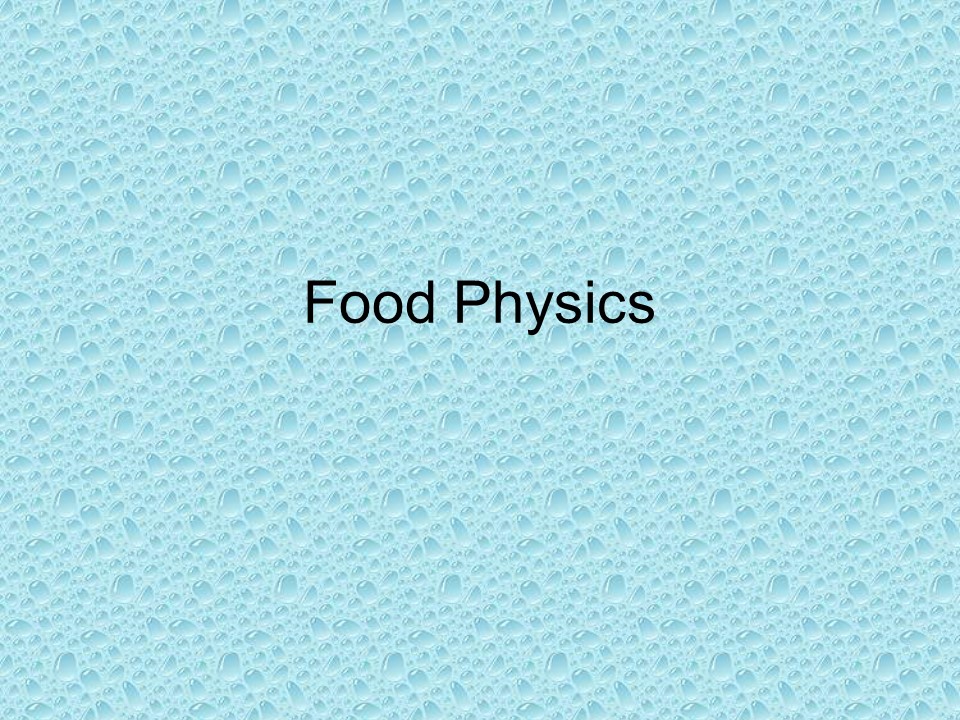Food Physics PowerPoint PPT Presentation
1 / 18
Title: Food Physics
1
Food Physics
2
Water in Food
- Water has three states Liquid, solid, gas.
- In food water is either added, removed, or
altered in food (typically altered) - Ice floats due to hydrogen being spaced further a
part as compared to the usual alignment. - Tetrahedron is the 4 hydrogen bonds that form
between water molecules.
3
Interfacial Tension
- Water has different forces
- 1. Attraction to other water molecules.
- 2. attraction of water molecules for the surface
they may be on. - 3. To each other when against air.
4
Osmosis
- OsmosisFlow of water molecules from a place of
greater concentration to a place of lesser
concentration. - Example-All vegetable wilting.
- Why are vegetables kept wet at stores?
- TurgorWater pressure in cells to keep things
like vegetables crisp.. - Salt from dressings will take water out.
5
- Osmosis takes place in all canned fruits.
- Microbes have a water concentration of 80 where
salt and sugar at 40-50.
6
Water Activity
- Controlling water controls microbes.
- Water activity is indicated by aw.
- Common water activity formula is
- Aw Equilibrium relative humidity/ 100
- Equilibrium Relative Humidityreached when a
foods rate of water loss in the environment
equals its rate of water absorption in the
environment.
7
- Definition of mole 1) The quantity of a
substance whose mass, in grams, is equal to its
formula weight. Ex Iron (Fe) has a formula, or
molecular, weight of 55.85 grams. One mole of
iron would be 55.85 grams.2) Avogadro's number
6.022 x 1023
8
Moles in Water
- Water has a concentration of 55.6 moles.
- If 1 mole is added to 1000 grams of water it now
contains 56.5. - Water Activity is the number of water molecules
relative to the total number of molecules
present. What would the water activity be in
this example
9
- 55.6/56.6 .982 which would mean that for every
1000 molecules of solution there is 982 water
molecules. - In this case humidity inside the food would be
98.
10
Proteins
- Proteins function around water.
- Water protein have a synergistic relationship
(mutual cooperation) - Proteins always have a single layer of water
around them. - The water layer is the reason why freezing does
not kill microbes. - Even freeze dried foods have a water layer.
11
pH Adjustment
- pH will change the water molecules around
protein. - Lets take a closer look at this concept.
12
- You have made curds and whey.
- The acid in vinegar stopped the amino acids from
bonding which caused the curds. Basically the
proteins collapsed out of the milk. - Precipitate is the fall out materials technical
name, something that comes out of a solution that
has evaporated.
13
Lipid Physics
- What is the difference between vegetable oil and
shortening? - Hydrogenation
14
Role of Heat
- Oil is not passive in cooking.
- Melting Point-temp where fat becomes liquid.
- Smoke Point-release of volatile molecules.
- Flash Point-ignitable vapor, volatile molecules
are heavier. - Fire Point-oil will burn
15
Hydrophobic
- Oil and water
- Immiscibility-inability of two liquids to mix.
- Water is dipolar (energy) and fat that has
triacylglyceriades are not. Again with pH this
does change in proteins that have lipids.
Proteins will bond but the fat will not.
16
Carb Physics
- Carbs absorb large amount of water in the polymer
stage. - A polymer is a large molecule (macromolecule)
composed of repeating structural units typically
connected by covalent chemical bonds. - In this case the C, H, and O with oxygen holding
various groups together.
17
Starches
- Cold water little solubility, hot water it is
spaghetti time. - Starch gels, forms a viscous (does not flow well)
liquid. - Pudding is a common example due to the polysacs.
18
Pectins
- A polysaccharide extracted from the cell walls of
plants, especially of fruits under acidic
conditions it forms a gel. It is often used in
processed foods, especially jellies and jams
where it causes thickening (setting). - Pectins are linear polymers of galacturonic acid
joined by bonds that allow side sugar chains.
Hydrogen during cooling bonds to lead to gels. - Pectin has two gels high methoxyl content and
low content methoxyl. - Both used to make jelly, one high sugar the other
not.

